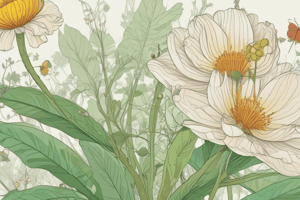Podcast
Questions and Answers
What is required for a flower to eventually turn into a fruit?
What is required for a flower to eventually turn into a fruit?
- The right temperature and soil
- Sunlight and water
- Pollen from another flower (correct)
- A certain type of insect nearby
What is the main role of animals or insects in flower reproduction?
What is the main role of animals or insects in flower reproduction?
- To provide nutrients to the plant
- To pollinate flowers (correct)
- To produce seeds
- To disperse fruit
What is the characteristic of flowers that contain both male and female parts?
What is the characteristic of flowers that contain both male and female parts?
- They are always brightly colored
- They are carnivorous
- They are always fragrant
- They are self-pollinating (correct)
What happens to some fruits, like poppies or marigolds?
What happens to some fruits, like poppies or marigolds?
What is the purpose of pollen in the reproduction process of flowers?
What is the purpose of pollen in the reproduction process of flowers?
What is the main purpose of a flowering plant producing colorful and scented flowers?
What is the main purpose of a flowering plant producing colorful and scented flowers?
What happens to a flower after it is pollinated?
What happens to a flower after it is pollinated?
Why is it important for seeds to be distributed far away from each other?
Why is it important for seeds to be distributed far away from each other?
What do emerging shoots need to grow and develop?
What do emerging shoots need to grow and develop?
Why do plants use different methods to distribute their seeds?
Why do plants use different methods to distribute their seeds?
Flashcards are hidden until you start studying
Study Notes
Life Cycle of a Flowering Plant
- Most plants need to be pollinated to reproduce, and flowering plants achieve this by producing flowers that attract insects or other animals to spread their pollen to other plants.
- Flowers are designed to attract pollinators, which is why many are colorful and scented.
Pollination
- All flowering plants rely on animals or insects to pollinate them, with most relying on insects, but some using birds.
- Each flower needs to be pollinated with pollen from another flower.
Seed Distribution
- Once the fruit has ripened, the seeds are ready to be distributed, and it's vital that they're spread far apart.
- Different plants use various methods to distribute seeds, including wind, water, and animals eating them.
Germination
- With enough light and water, a seed will germinate, and the emerging shoots need lots of light but get most of their nutrients from the seed.
Growth
- As the plant grows, it requires more nutrients from the soil, and if seeds grow too close together, they'll compete for water and nutrients and not grow as strongly.
Fruit
- If a flower is pollinated, it will turn into a fruit, and all flowering plants produce fruit, but not all fruits are edible or traditional fruits.
- Some fruits turn into seed pods, as seen in poppies or marigolds.
Flowering
- When a flower matures, it will start to produce flowers that contain both male and female parts, and if pollinated, this flower will eventually turn into a fruit.
Studying That Suits You
Use AI to generate personalized quizzes and flashcards to suit your learning preferences.



